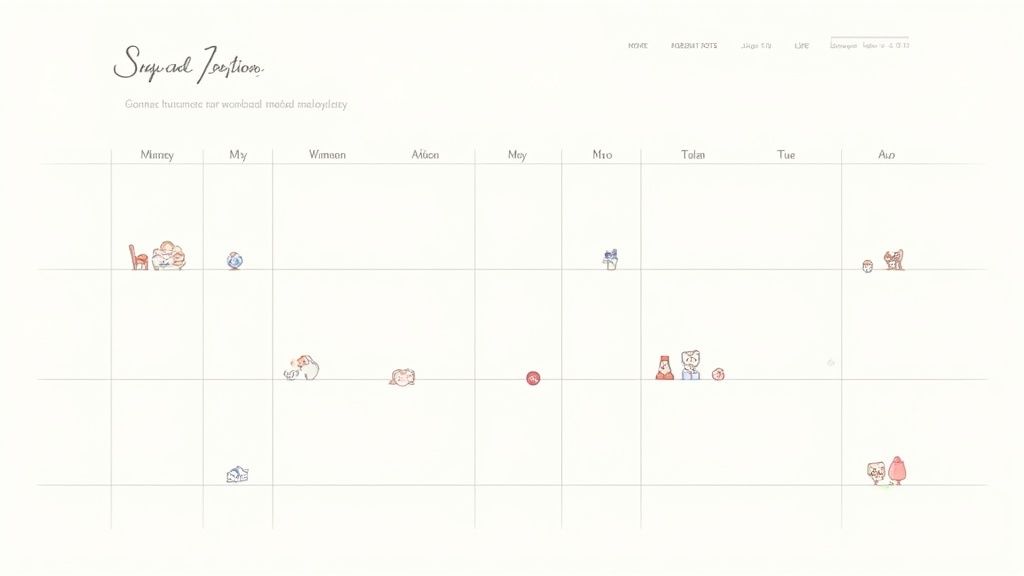The Strategic Foundation of Content Calendars

Successful brands understand the power of strategy. They know a social media content calendar is more than a scheduling tool; it’s the backbone of their social media presence. This realization has shifted businesses from reactive posting to proactive planning, allowing them to create compelling narratives and foster deeper connections with their audiences.
Aligning Social Media With Broader Marketing Goals
A key benefit of a content calendar is its ability to align social media activity with overall marketing objectives. For example, during a new product launch, the calendar ensures social media posts support the launch, amplifying the message and expanding its reach. This integrated approach maximizes marketing campaign impact. It also keeps teams synchronized, contributing to a more cohesive brand experience.
Maintaining Consistency Across Platforms
A social media content calendar promotes consistency across various platforms. It serves as a central hub for planning and scheduling content across different channels, ensuring a unified brand voice and message. This consistency is essential for building brand recognition and trust. A regular posting schedule keeps your audience engaged and reinforces your brand’s presence.
This organized approach is a hallmark of successful businesses. In fact, 64% of the most successful businesses use a documented content strategy, often incorporating a social media content calendar. This structured approach helps align content with marketing goals and maintain consistency across platforms. Find more statistics here: SproutSocial Insights on Content Calendars
Adapting to Market Shifts and Trends
The online world is in constant flux. A well-structured social media content calendar enables businesses to adapt to market changes. If a current event impacts their industry, the calendar can be adjusted to include relevant content, showcasing responsiveness and maintaining audience engagement. This flexibility ensures social media strategies remain current and effective. A content calendar provides the framework for staying ahead of the curve and leveraging emerging trends. It allows brands to participate in relevant conversations and solidify their position as industry leaders. By anticipating and addressing trends, businesses can connect more deeply with their audience and showcase their expertise.
Measurable Benefits That Drive Real Results
A social media content calendar isn’t just about organization. It’s a powerful tool for achieving measurable results. By shifting from reactive posting to strategic planning, businesses unlock a range of benefits that directly impact their bottom line. Let’s explore how a well-structured calendar can transform social media effectiveness.
Increased Team Productivity and Efficiency
Imagine your social media team scrambling for last-minute content ideas. This chaotic approach drains resources and hinders productivity. A social media content calendar eliminates this frantic energy by allowing for advanced planning.
This empowers teams to batch content creation, freeing up time for strategic initiatives like audience engagement and campaign analysis. This shift from reactive to proactive work contributes significantly to overall team efficiency.
Enhanced Content Quality and Consistency
A social media content calendar isn’t just a scheduling tool. It’s a platform for crafting higher-quality content. With a clear plan in place, teams can focus on developing well-researched, engaging posts that resonate with their target audience.
This dedicated planning time also allows for meticulous editing and refinement, ensuring polished and impactful content. A consistent posting schedule, facilitated by the calendar, strengthens brand identity and fosters audience loyalty. Maintaining a consistent brand voice and style is key to engaging audiences and building a strong brand presence. Explore this topic further: Sprinklr’s insights on social media content calendars
To illustrate the advantages of a content calendar across different organizational levels, consider the following table:
Content Calendar Benefits by Organization Size: This table compares how different sized organizations benefit from implementing social media content calendars.
| Benefit | Small Business | Mid-Size Company | Enterprise |
|---|---|---|---|
| Increased Productivity | Streamlines workflows and maximizes limited resources | Improves team collaboration and project management | Enables efficient content distribution across multiple teams and channels |
| Enhanced Content Quality | Ensures consistent branding and messaging | Facilitates more strategic content development | Allows for data-driven content optimization and personalization |
| Improved Audience Engagement | Builds stronger relationships with customers | Increases brand visibility and reach | Drives targeted campaigns and measurable ROI |
As demonstrated above, regardless of size, businesses can leverage a content calendar to significantly enhance their social media efforts. From improved productivity to increased audience engagement, the benefits are substantial and impactful.
Measurable Audience Growth and Engagement
One of the most compelling benefits of a social media content calendar is its impact on audience growth and engagement. A consistent posting schedule, combined with high-quality content, attracts new followers and keeps existing ones engaged.
This increased visibility translates into greater brand awareness and reach. By planning content around specific themes and campaigns, businesses can target niche audiences more effectively, fostering deeper connections and ultimately driving conversions.
Improved Performance Metrics
A well-executed social media content calendar provides the framework for tracking and analyzing key performance indicators (KPIs). By monitoring metrics like engagement rates, reach, and website traffic, businesses can gain valuable insights into what resonates with their audience.
This data-driven approach enables continuous improvement and optimization of the social media strategy. The ability to measure and analyze the impact of content allows for adjustments to the calendar, ensuring resources are allocated to the most effective tactics.
Building a Calendar That Actually Works

A social media content calendar is much more than a simple scheduling tool. It’s a strategic blueprint for delivering your content effectively. This means thinking beyond just listing post dates and times. Instead, you need to focus on the core elements that transform a basic calendar into a powerful, high-performing asset. Let’s explore these key components.
Incorporating Content Themes and Campaign Timelines
Organizing your content around themes is crucial for an effective calendar. Think of themes as broad topics that align with your brand and resonate with your target audience. For a fitness brand, a monthly theme could be “Summer Fitness Tips.” Individual posts within this theme might cover topics like hydration, outdoor workouts, or healthy summer recipes.
Integrating campaign timelines into your content calendar ensures coordinated execution across various platforms. This consistency in messaging amplifies your campaign’s impact and avoids last-minute scrambling for content, maintaining a steady flow of engaging material.
Platform-Specific Optimizations
Every social media platform has its own unique characteristics. A successful content calendar acknowledges these differences and incorporates platform-specific optimizations. This could involve tailoring content formats, adjusting posting times, or leveraging platform-specific features like Instagram Stories or Twitter polls. Adapting your approach to each platform’s strengths will maximize engagement.
Balancing Evergreen and Trending Content
While planning is essential, staying relevant requires incorporating trending topics. A well-structured calendar balances evergreen content (timeless, always-relevant posts) with timely, trending topics. This involves allocating space for pre-planned content while remaining adaptable enough to capitalize on current conversations. This keeps your content fresh and engaging, attracting new followers while retaining your existing audience.
Visual Asset Workflows
Visuals are essential for social media engagement. Creating high-quality visuals, however, can be time-consuming. A robust social media content calendar should incorporate a clear workflow for visual asset creation. This might involve assigning responsibilities, setting deadlines, and pre-planning visual themes to maintain a consistent brand aesthetic. This proactive approach prevents last-minute rushes for visuals, allowing your team to focus on strategic content development.
Cross-Team Collaboration and Platform Requirements
Collaboration is key to social media success. A shared content calendar serves as a central hub for cross-team communication, ensuring everyone is on the same page regarding content strategy and timelines. The calendar should also account for the specific needs of each platform you use. This might involve different posting frequencies, content formats, or approval workflows. By addressing these platform-specific needs, your calendar becomes a customized solution for managing your diverse social media presence, improving team efficiency and maximizing impact.
From Blank Page to Working Calendar
Creating a social media content calendar can feel overwhelming. However, breaking it down into smaller steps makes the process much more manageable. This section offers a practical guide to building a functional social media content calendar, from initial setup to daily use.
Conducting a Content Audit
Before developing new content, it’s essential to understand what’s already out there. A content audit involves reviewing your past social media posts. This helps identify what has resonated with your audience and what hasn’t performed well. This analysis provides valuable information for shaping your future content strategy. A content audit doesn’t need to be complicated. A simple spreadsheet listing past posts, engagement metrics, and key observations can provide valuable insights.
Establishing Realistic Production Timelines
Building a social media content calendar requires a realistic assessment of your team’s capabilities. Overly ambitious schedules often result in burnout and lower-quality content. Begin by evaluating how much time your team can realistically dedicate to content creation each week. From there, develop a production timeline that aligns with these resources. For example, if your team can produce two high-quality posts per week, schedule accordingly. Don’t try to force a daily posting frequency if it strains your team’s resources.
Creating Sustainable Workflows
A sustainable workflow ensures consistent content output without overwhelming your team. This means defining clear roles and responsibilities, streamlining approval processes, and using helpful project management tools like Asana. This structured approach keeps everyone aligned, promotes efficient collaboration, and helps maintain a consistent posting schedule. Assigning specific team members to different content creation stages (writing, editing, and visual design) can significantly improve workflow efficiency.
Determining Optimal Posting Frequency
There’s no universal rule for how often you should post on social media. The ideal posting frequency depends on your audience, the platform you’re using, and the type of content you share. Experiment with different posting schedules and track your engagement metrics to find what works best. Some audiences may appreciate daily updates, while others prefer less frequent, more in-depth content. Finding the right balance is key to keeping your audience engaged without overwhelming their feeds.
Using a social media content calendar can significantly reduce the stress of constantly coming up with new content ideas under pressure. Planning and scheduling posts in advance helps businesses ensure their social media campaigns are coordinated and relevant. This proactive strategy allows companies to align their content with specific events, holidays, and marketing initiatives. Learn more about the benefits of a social media content calendar here: Social Media Strategies Summit Blog on Content Calendars
Implementing Effective Approval Processes
An efficient approval process is vital for maintaining quality control and brand consistency. This process may involve multiple stages, such as initial drafts, revisions, and final approval before publishing. Establish clear guidelines and timelines for each stage to avoid delays. Using collaborative tools, like Google Docs, allows team members to provide feedback and track changes efficiently. This streamlined system reduces bottlenecks and ensures that all content aligns with brand standards.
Building In Flexibility
While planning is crucial, remaining adaptable is equally important. The social media landscape is constantly changing. A rigid calendar can limit your ability to leverage trending topics or respond to current events. Incorporate buffer time into your schedule to accommodate unexpected opportunities or urgent updates. This flexibility ensures your social media content calendar remains a valuable tool for navigating the dynamic world of social media. This adaptability empowers your team to react to trending topics and maintain high audience engagement.
Selecting The Right Tools For Your Team

Finding the perfect social media content calendar tool can be challenging. With so many options available, from basic spreadsheets to full-fledged enterprise platforms, choosing one that fits your team’s needs and workflow is essential. This section explores the different options and offers insights into selecting the right solution for your social media strategy.
Key Considerations When Choosing A Tool
Several factors contribute to a social media content calendar tool’s effectiveness. Team collaboration features, for example, are critical for streamlined workflows. Look for tools that allow task assignments, feedback sharing, and progress tracking.
Another vital aspect is analytics integration. Tracking KPIs directly within your calendar provides valuable insight into content performance and informs future strategies. This data-driven approach allows for continual optimization.
Finally, consider the learning curve. A user-friendly interface reduces training time and ensures quick adoption. This is particularly important for smaller teams. An intuitive tool saves time and effort.
Exploring Different Calendar Solutions
Understanding the strengths and weaknesses of each option, from free templates to paid platforms, is crucial for making informed decisions.
- Free Templates: These are great starting points, especially for small teams or those new to content calendars. They offer a basic organizational framework but often lack advanced features. A simple spreadsheet can serve as a basic content calendar but may become difficult to manage as your needs grow.
- Mid-Tier Platforms: These balance affordability and functionality, typically including team collaboration, basic analytics, and content scheduling. Tools like Trello or Asana can be adapted for social media content calendars.
- Enterprise Platforms: Designed for larger teams and complex workflows, these offer advanced analytics, content approval workflows, and integration with other marketing tools. Platforms like SproutSocial or HubSpot offer comprehensive features for managing large-scale campaigns.
Matching Solutions To Team Structures And Workflows
The right tool depends on your team’s structure and content volume. A free template or simple project management tool may suffice for small teams with limited output. As your team and content grow, a more robust platform may be necessary.
Consider your approval workflows. If multiple stakeholders need to review content before publishing, ensure your tool supports these processes efficiently. Some tools offer built-in approval workflows to streamline this.
Evaluating Scalability And Implementation Challenges
As your business grows, your tool should scale with it. Avoid tools that may become limiting as your content volume and team size increase. Consider the tool’s ability to handle increasing demands.
Anticipate implementation challenges. Transitioning to a new tool requires training. Factor this into your decision and choose a tool that offers adequate support for a smooth transition. Some platforms offer onboarding services to assist teams.
To help you compare different options, we’ve compiled a table summarizing the key features and limitations of some popular content calendar tools:
Content Calendar Tool Comparison: A comparison of popular social media content calendar tools and their key features
| Tool | Price Range | Best For | Key Features | Limitations |
|---|---|---|---|---|
| Google Sheets/Excel | Free | Individuals, small teams | Customizable, easy to use | Limited collaboration features, manual updates |
| Trello | Free – Paid | Small to medium teams | Visual organization, task management, basic analytics | Can become complex for large teams |
| Asana | Free – Paid | Medium to large teams | Project management, workflow automation, team collaboration | Steep learning curve for some features |
| SproutSocial | Paid | Large teams, agencies | Advanced analytics, content scheduling, social listening | Higher cost |
| Hubspot | Paid | Large teams, enterprises | All-in-one marketing platform, CRM integration, automation | Complex setup, higher cost |
This table provides a quick overview of the various tools available. Consider your specific needs and budget when making a decision.
Choosing the right tools is a crucial step in maximizing your content calendar’s effectiveness. Careful consideration of these factors will help you select a solution that empowers your team and drives results. Prioritize functionality, scalability, and user-friendliness for a successful implementation.
Content Planning Strategies That Drive Engagement
A social media content calendar is essential for organized posting, but it’s only as effective as the content it delivers. A well-structured calendar won’t drive engagement without a robust content strategy. This section explores planning content that resonates with your audience and achieves your marketing goals.
Identifying Optimal Posting Times
Timing is everything in social media. Posting content when your audience is most active is crucial for maximizing visibility and engagement. Analyzing your audience’s online behavior is key. When are they most active on each platform?
Tools like SproutSocial offer insights into audience activity, helping you pinpoint the optimal posting windows. Strategic timing ensures your content reaches the largest possible audience when they’re most likely to interact.
Creating Resonant Content Themes
Organizing your social media content into themes creates a consistent brand narrative. These themes should resonate with your target audience and align with your brand’s message. Think of it like categories on a restaurant menu, each offering different options but contributing to a cohesive dining experience.
For example, a fitness brand might use themes like “Healthy Recipes,” “Workout Routines,” or “Wellness Tips.” Each theme allows for varied content formats, from motivational images to informative articles. This thematic approach provides structure and keeps your content focused.
Balancing Promotional and Relationship-Building Content
Promoting your products or services is essential, but a constant barrage of sales messages can alienate your audience. Balance promotional posts with content that builds relationships and fosters genuine connections.
Sharing behind-the-scenes content, asking engaging questions, or providing valuable industry insights can strengthen your audience’s connection with your brand. This balance positions you as a valuable resource, not just a salesperson.
Planning Content Series and Repurposing Content
A content series, like a sequence of videos or articles, can build anticipation and keep your audience returning for more. This creates a sense of ongoing value and encourages continued engagement.
Content repurposing extends the lifespan and reach of your content. Transform a webinar into a series of social media posts, or create short video clips from longer videos. This maximizes your content’s impact without requiring constant creation from scratch.
Incorporating Trends and User-Generated Content
Staying relevant in the dynamic social media landscape means incorporating trending topics and user-generated content (UGC). Just as a restaurant might add seasonal dishes to its menu, incorporating trending topics keeps your content fresh and engaging.
UGC, like customer reviews or photos featuring your product, provides valuable social proof and strengthens your community. Featuring UGC shows you value your customers and encourages interaction. This adds authenticity and strengthens your brand connection. It also provides diverse content resonating with different segments of your audience.
Measuring Impact and Refining Your Approach

A social media content calendar isn’t a set-it-and-forget-it tool. It’s a dynamic resource that thrives on adaptation and improvement. This means regularly evaluating your content’s performance and using that data to refine your strategy. This section explores how to make your calendar a living document that grows with your audience and aligns with your business goals.
Establishing Meaningful Performance Benchmarks
Before assessing impact, you need to define success. Establishing clear key performance indicators (KPIs) is essential. These KPIs should directly connect to your overall business objectives.
For instance, if your goal is to boost brand awareness, your KPIs might include reach, impressions, and social mentions. If your goal is driving sales, track website clicks, conversions, and revenue generated from social media. These benchmarks provide a foundation for gauging progress and spotting areas for improvement.
Tracking the Right Data Points
After establishing your KPIs, consistent tracking is vital. Most social media platforms offer built-in analytics dashboards, providing valuable insights into post performance.
Focus on metrics like engagement (likes, comments, shares), reach (how many users saw your content), and website clicks. This data provides a narrative of what resonates with your audience and what doesn’t. This information is crucial for refining your content strategy.
Implementing Review Cycles for Continuous Improvement
Regularly reviewing your social media content calendar’s performance is fundamental for continuous improvement. Schedule dedicated review periods, whether weekly or monthly, to analyze data and identify trends.
What content resonated most? Which posting times generated the most engagement? These insights can inform future content planning and optimize your calendar for maximum impact. Regular reviews keep your calendar aligned with your audience’s evolving preferences.
Conducting Effective Content Retrospectives
Beyond basic data analysis, in-depth content retrospectives offer deeper insights. These retrospectives involve a detailed examination of specific campaigns or content themes.
Ask questions like: What was successful? What could be better? What lessons were learned? These discussions, involving your entire social media team, can reveal hidden patterns and generate new ideas. This collaborative approach promotes continuous learning and improvement.
Identifying Successful Patterns in Your Posting Strategy
As you analyze your data, look for recurring patterns. Do certain content formats consistently outperform others? Are there specific posting times or days that yield higher engagement?
Identifying these patterns helps refine your posting strategy and optimize your social media content calendar. For example, if video content consistently outperforms images, you might increase video production.
Making Strategic Refinements Based on Audience Response
Your audience’s response provides invaluable feedback. Pay attention to comments, shares, and direct messages. What are people saying about your content? What questions are they asking?
Use this feedback to refine your calendar and deliver resonant content. Addressing audience feedback demonstrates that you value their input and strengthens relationships. This bolsters community engagement and fosters loyalty, an audience-centric approach crucial for long-term social media success. Adapting your calendar based on these insights ensures you remain relevant and continue providing valuable content. By treating your calendar as a living document, you’re setting the stage for a dynamic and successful social media strategy.
Ready to transform your social media presence with a data-driven approach? ReachLabs.ai can help. We offer comprehensive social media marketing services designed to elevate your brand and achieve your business objectives. Visit ReachLabs.ai today to learn more.





